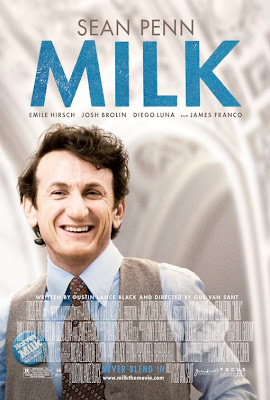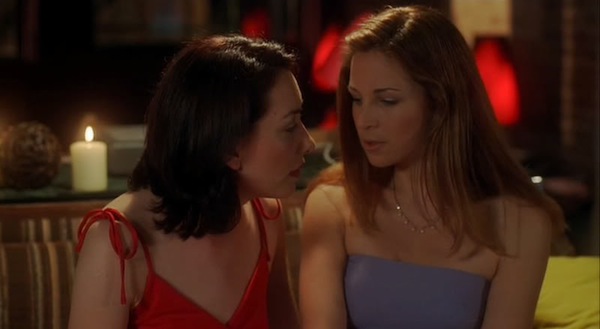 |
| (Pour me another … this is going to be a long night.) |
The film wasn’t just lauded as a cinematic achievement, it was also celebrated as a “positive” and “honest” representation of quotidian lesbian life in an age where gay marriage dominates any discussion of LGBT people. In addition to multiple Academy Award nominations—for acting, writing, and best picture, but not, interestingly enough, best director—the film has 93% positive reviews on rottentomatoes, so pretty much everyone who gets to decide that movies are good told us that this one was worthy of our time. Many of the reviews focus on the film’s supposedly groundbreaking “realistic” depiction of lesbians (I guess these people have never seen The Hunger.) Eric Snider from film.com refers to the characters as “realistically portrayed.” A.O. Scott from the New York Times writes: “The performances are all close to perfect, which is to say that the imperfections of each character are precisely measured and honestly presented.” Tom Long of the Detroit News called it “one of the year’s most honest and endearing films.” (“Honest” is the key word in all of these reviews. We might want to think about what it means to call a work of fiction “honest.” To say that it is “honest” means that it confirms, in some way, our worldview; it proves something we think to be true.) And then there is this gem from The Wall Street Journal, which really sums up the self-congratulatory, progressive reviews of this film: “The basic joke here, and it’s a rich one, is that the dynamics of gay marriages differ little from those of straight marriages.” This is, of course, the ultimate compliment that the mainstream press can make about queer people—that they are just like straight people. Judging from the film, what seems to be at stake is whether or not gay married couples can be as unhappy and passive aggressive as straight married couples, thus making them more deserving of legal protections.
In a Shewired.com article by Kathy Wolfe, the founder of Wolfe, the world’s largest exclusive distributor of lesbian and gay movies, Wolfe sings the film’s praises for its place in lesbian film history, calling it, without a shred of irony, “The Lesbian Brokeback Mountain”:
For a variety of reasons, The Kids Are All Right will be the most widely distributed lesbian-themed mainstream movie in history. Like that beloved yet sad gay cowboy movie, it has major stars in the gay roles: Julianne Moore and Annette Bening as lesbian moms. This ensures that the film will reach a wide audience. Most exciting of all — with its entertaining yet ultimately politically powerful message of putting a lesbian family front and center — the film will open hearts and minds very much like Brokeback did on its theatrical release.
Let’s read that statement again: “the politically powerful message of putting a lesbian family front and center.” What makes the film a positive political intervention, for Wolfe, is that lesbians exist as subjects, never mind the content of the film. Wolfe goes on to discuss “how far we’ve come” in the representation of lesbians in cinema and express her gratitude for the wide release of this film—suggesting that the sheer existence of LGBT-themed films by LGBT people (Cholodenko is queer-identified) is an unquestionably good thing for LGBT people, no matter what the films are about.
OK—so that’s the story about the film. Now, what of the film itself?
Let’s start with perhaps the most memorable scene in the movie, which finds Jules and Nic trying to make whoopee, but unable to get into the groove. They call in the big guns, as it were, and pop in some outdated gay male porn to get their juices flowing. Nic watches the porn while Jules—completely covered by bedding, because, you know, why would anyone want to see themselves having sex with Julianne Moore? So much for realism—takes care of business. Their annoying son catches them in the act and has a few questions about their choice of aphrodisiac. The entire sexual encounter has been a letdown from the get-go, but the interruption by the annoying son ensures that nobody will be getting off tonight. In one of the film’s funniest scenes, Jules comments on the “realism” of lesbian pornography, suggesting that it isn’t erotic because the women in the film aren’t lesbians, which is, I’m assuming, a kind of joke about the film we are watching, in which two A-list straight actors are playing gay. What is so interesting about that joke is that it complicates the film’s own politics of representation (as articulated by Wolfe): Jules’ comment debunks the myth that any representation of queerness is as satisfying (sexually or otherwise) as any other.
 |
| (Headache? Great. I hate having sex with women.) |
Contrast this underwhelming sex scene with the two opposite-sex sex scenes in the film. At the risk of generalizing and making normative claims about what constitutes good sex, both of the opposite-sex sex scenes—one with the Hulk and Julianne Moore, the other with the Hulk and Yaya DaCosta—are, objectively speaking, super f’ing hot. I mean, they are legit sex scenes. People are naked. People are getting off. Bodies are touching. There are noises. And rhythms. When Mark Ruffalo has sex with women, it is sweaty, passionate, multi-positioned, ass-baring, the-hills-are-alive-with-the-sound-of-heterosexuality sex; when Jules and Nic have sex, it is sad, lifeless, awkward and unsatisfying for literally everyone involved. It is unsatisfying for the women, who have a grin-and-bear it look on their faces; it is unsatisfying for the audience if they came to see cunnilingus so realistic that it would make them regret going to see the film with their parents (luckily Black Swan also came out in 2010); and it is unsatisfying for the women’s children, for whom their moms’ sexuality is a perpetual source of embarrassment: their porn, their toys, their PDA all elicit disgust from their children. And not just the typical “Ew gross my parents have sex” response, but legitimate mortification that the movie suggests feeds the children’s desire to meet their sperm donor. Their parents, according to the narrative, just aren’t enough for them—and they certainly aren’t enough for each other.
 |
| (Lesbian heartthrob, Mark Ruffalo.) |
The contrast is, of course, the point. Jules and Nic are in a marriage-funk—Lesbian Bed Death and all that—thus Jules’s decision to look for new sexual thrills. I don’t think there is anything wrong with showing an unsuccessful or disappointing sexual encounter between queer women. I don’t think there is anything wrong with the fact that in a movie about queer women, the women need gay male porn to get off, or even that they desire and engage in sex with men, something to which some LGBT blogs and writers took exception (“girl, do you” pretty much sums up my philosophy on consensual sexual activity in movies or real life). But it does give one pause that a movie ostensibly about lesbians cannot imagine the possibility of satisfying sex between women, even as opposite-sex sex is portrayed as reliably orgasmic (newsflash: it ain’t). This film, which is being called the “the Lesbian Brokeback,” is organized almost entirely around the rise and fall of Mark Ruffalo’s penis. The narrative is phallocentric in much the same way as pornography featuring a male-female-female threesome (or any hetero-aimed porno) is phallocentric: the man’s penis is depicted as the most satisfying sexual toy, the most direct line to women’s pleasure. Sure, women can do some stuff to each other…but it’s basically foreplay, if it amounts to anything at all.
Further proof of the film’s phallocentrism comes from a quick search on IMDB where the plot key words listed for this film are:
There is no mention of lesbians, motherhood, marital problems, or women at all. The fact that Mark Ruffalo’s character owns a goddamn restaurant seems to have more relevance than the fact that this is a movie about queer women. Moreover, the title of the film, which is the name of a Who song, emphasizes the well-being of the children—(See, gay moms can produce annoying, maladjusted and ungrateful teens, just like you!)—and deemphasizes the women who are supposedly kept “front and center.” For a movie that is being called a crowning achievement of lesbian cinema, lesbianism always seems to be not quite the point.
 |
| (They are the worst.) |
Now, a movie about lesbian moms and the grown children who resulted from their insemination could, one would imagine, take on many forms. What we should be asking is: why this form? Why this story, and why this story as the one that we elevate to an enshrined place in lesbian cinema (It made the top 30 on an IMDB list of the “Best Lesbian Movies”). When critics call the depiction of lesbians “honest” what worldview has the film confirmed for them? It seems to me to confirm the lesson espoused by another “classic lesbian-themed” film, Chasing Amy—that all lesbians really want, all they really need, is sex with men. And none of this would bother me nearly as much if people didn’t talk about movies like this as “changing hearts and minds” and battling homophobia. It’s Glee-syndrome. If everyone involved in the movie—including the critics who reviewed it and the audiences who raved about it—weren’t so self-congratulatory, you might just be able to experience this as the mediocre film it is and relish in Annette Bening’s mastery of awkward tipsy dinner conversation.



































